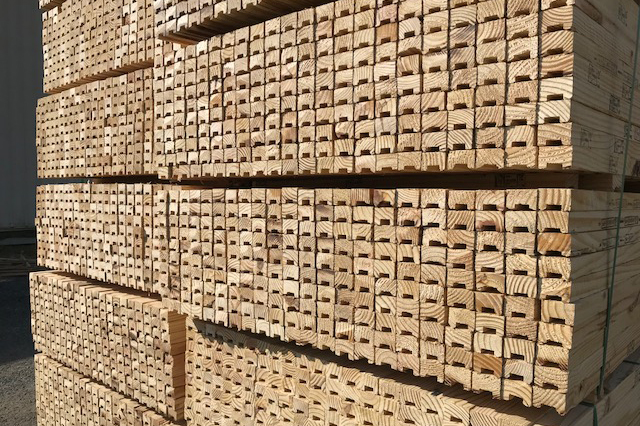Banding groove is one of those things that you’ve probably seen many times, but you may not have known what it was called or why it is used.
As with so many other industries, the industrial wood industry also has its own set of terms and lingo with a deep history rooted in the forestry, logging, and construction trades. And that doesn’t even account for regional differences in terms, which can vary greatly.
So, What Is Banding Groove?
As the name suggests, banding groove is a wood product with a groove cut into it. To be more precise, it’s dunnage with a groove cut into the length of the lumber.
For those who don’t know, dunnage is low-grade wood material that’s used to separate, bind, or protect products during shipment. More specifically, dunnage can be stakes, strips, planks, or blocks of additional wood that are used to pad or protect a load, but it can also be wood used for chocks to keep products from moving. It’s kind of the catch-all term used for low-grade wood that’s used as a complement to regular packaging such as pallets or crates.
To make the term more confusing, dunnage can also be other things used in packaging to keep products from moving. We’re talking about more of the engineered products here, such as foam, plastic, corrugate, paper, bubble wrap, packing peanuts, and even metal. If you purchase a refrigerator, for example, all the packaging materials inside the box that keep the fridge from shifting during transport are also considered dunnage.
So, let’s get back to banding groove.
Banding groove is essentially wood dunnage with a groove cut into it. Like the majority of dunnage products, banding groove is intended to provide protection.
How Is Banding Groove Used?
A lot of different products use plastic or metal banding to help secure the unit load. They either strap the product down to the pallet or crate, or they use strapping in the internal packaging to keep products from shifting during transport.
Although designed to protect, sometimes the strapping can cause damage to the products. That’s where banding groove comes into the picture.
Dunnage strips are cut to size, then a groove is cut down the length of the wood that is the same width as the strapping. When packing the products up, the banding groove will be placed between the product and the strapping. That way, the strapping can be tightened down enough to hold the product, but the tension on the straps won’t damage the product or cause in-transit damage.
The banding groove kind of acts like a buffer between the strap and product.
Banding groove can also help provide clearance for the fork tines of a forklift or hand truck. The banding groove helps to keep strapping in place on the unit load. If a strap slips down, it can cause problems when you’re trying to move palletized products around. Essentially, banding groove immobilizes the strapping and keeps it in its proper place so that it doesn’t slide off the product or off the pallet or crate.
Is Banding Groove Custom Cut?
In order to properly protect your unit loads and fit the size of strapping that you’re using, banding groove has to be cut to the size needed. That means that the size of the groove is important, as well as the dimensions and thickness of the strips. If the strips are too thin, then they break under the strap tension. If the strips are too big, then they won’t properly protect your products or stabilize the unit load.
This is all something that a qualified packaging designer can help you with.
Wrapping It Up
Banding groove is an invaluable part of the packaging for a wide variety of products. It’s also something that you’ve probably seen many different times. Now you know what it’s called and why we use it in the packaging industry.
Here at Conner, we produce a lot of banding groove.
With special cut lines designed to rip, groove, trim, and stamp in a single pass, our efficiency translates into big cost savings and fast turnarounds for our customers. If you’re looking for banding groove, reach out to us. We can help you figure out the right-sized banding groove you need to properly protect your products from strap damage.
*Updated 6/28/2022*


![[PRESS RELEASE] Conner Industries Announces Major Guardian Packaging Expansion](https://conner.b-cdn.net/wp-content/uploads/2024/10/Guardian-Packaging-Expansion-500x383.jpg)
![[PRESS RELEASE] Conner Industries Announces Website Dedicated to Integrated Packaging Division](https://conner.b-cdn.net/wp-content/uploads/2024/05/Conner-Packaging-Blog-500x383.jpg)


